Nicola Cornick's Blog, page 24
December 13, 2011
The Ghost of Seckford Hall!
Last week I was on my travels again, this time to Suffolk and to the wonderful Seckford Hall Hotel. If Seckford Hall had been designed with a historical romance writer in mind it could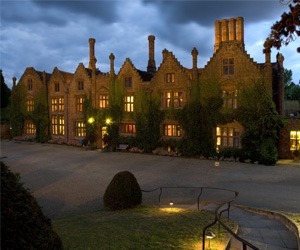 not be more perfect. There is everything here – a Tudor manor house with a fascinating history, wonderful rooms that retain so much period atmosphere, a lucky black cat, friendly staff, delicious food (the cucumber mousse was to die for), a secret passageway and of course the resident ghost. We had a cosy little room with a splendid balcony that looked out across the gardens to the lake. Under the moon and the winter stars it was impossibly romantic.
not be more perfect. There is everything here – a Tudor manor house with a fascinating history, wonderful rooms that retain so much period atmosphere, a lucky black cat, friendly staff, delicious food (the cucumber mousse was to die for), a secret passageway and of course the resident ghost. We had a cosy little room with a splendid balcony that looked out across the gardens to the lake. Under the moon and the winter stars it was impossibly romantic.
The secret passage was said to connect Seckford Hall with Woodbridge Abbey, a few miles away, which was the town house of Thomas Seckford. Naturally he needed a secret passage to transport contraband goods from the port of Woodbridge inland. Smuggling was rife here on the East Coast, something which I drew on when I wrote my Bluestocking Brides series which was set in Woodbridge and the surrounding area. As with many other rumoured secret tunnels, the whereabout of the one at Seckford Hall is now unknown.
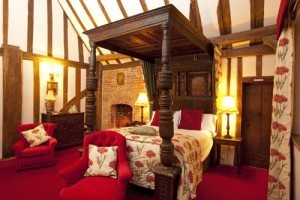 As for the ghost, it is said to be Thomas Seckford the Master, who was born in about 1515 and became one of the two Masters in the Ordinary of the Court of Requests. It was the Masters' role to accompany the sovereign when he or she travelled. As such Thomas Seckford was known to Queen Elizabeth I and she visited Seckford Hall and may even have slept in the magnificent fourposter bed in the Tudor Room! Sir Thomas is said to walk at night in his Elizabethan dress of steeple crowned hat and white clothing, carrying his wand of office as Master of Requests. It is his complaint that the money he left in the Seckford Trust for the benefit of the poor was embezzled by the rich. Apparently Sir Thomas's ghost was so active that one theory on why the east wing of the house was pulled down was that it was an attempt to prevent him from haunting the place.
As for the ghost, it is said to be Thomas Seckford the Master, who was born in about 1515 and became one of the two Masters in the Ordinary of the Court of Requests. It was the Masters' role to accompany the sovereign when he or she travelled. As such Thomas Seckford was known to Queen Elizabeth I and she visited Seckford Hall and may even have slept in the magnificent fourposter bed in the Tudor Room! Sir Thomas is said to walk at night in his Elizabethan dress of steeple crowned hat and white clothing, carrying his wand of office as Master of Requests. It is his complaint that the money he left in the Seckford Trust for the benefit of the poor was embezzled by the rich. Apparently Sir Thomas's ghost was so active that one theory on why the east wing of the house was pulled down was that it was an attempt to prevent him from haunting the place.
I have to be honest and confess that I had no close encounters with the ghost of Sir Thomas on the night I stayed at Seckford Hall. This was probably because I slept too well! As you know, I pride myself on being quite susceptible to atmosphere and on occasion – usually when I don't particularly want to – I have had the spookiest of experiences. There was a definite atmosphere at Seckford Hall but it felt more like the layers and layers of history wrapping about one than the unquiet spirit of a man whose ghost walks at night. That said, I don't rule out a sighting next time I return…
©2011 Nicola Cornick. All Rights Reserved.
.December 12, 2011
Christina Courtenay at the Word Wenches!
Today fabulous historical author Christina Courtenay is visiting the Word Wenches to talk about the research and inspiration for her latest book, Highland Storms. There is a copy of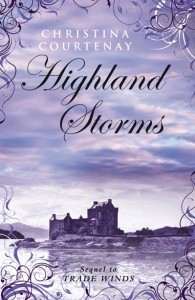 the book up for grabs for one lucky commenter so come along over and share your most romantic settings with the Wenches!
the book up for grabs for one lucky commenter so come along over and share your most romantic settings with the Wenches!
©2011 Nicola Cornick. All Rights Reserved.
.December 9, 2011
Two Romantic Ruins
Today is the last post about my Scottish travels and this one is dedicated to friend and fellow author Anna Campbell. Not, I hasten to add, because I think she is a romantic ruin, but because it is about the Scottish Borders and a visit to Jedburgh and Dryburgh Abbeys and I know that Anna loves the Borders (loves Scotland, in fact!)
We visited Jedburgh on the first frosty morning of the autumn. It was a glorious day (as you can see in our photo!) and the ruined abbey was looking stunning in the sunshine. Jedburgh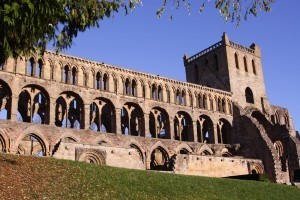 was an Augustinian Abbey founded around 1138 by King David I of Scotland and Bishop John of Glasgow. Its architecture is awe-inspiring and it is a place that still retains a very spiritual atmosphere. The river, the Jed Water, runs close by and during the time of the abbey it supplied water for the members of the community and also powered a grain mill and later mills producing wool and snuff. The monastery cloister gardens were replanted in 1986 with the same herbs that the Augustinian canons would have used for culinary and medicinal purposes. Even in the late autumn it was beautiful! I climbed to the top of the east end of the church and had a splendid view out across the town of Jedburgh which nestles close by the abbey walls.
was an Augustinian Abbey founded around 1138 by King David I of Scotland and Bishop John of Glasgow. Its architecture is awe-inspiring and it is a place that still retains a very spiritual atmosphere. The river, the Jed Water, runs close by and during the time of the abbey it supplied water for the members of the community and also powered a grain mill and later mills producing wool and snuff. The monastery cloister gardens were replanted in 1986 with the same herbs that the Augustinian canons would have used for culinary and medicinal purposes. Even in the late autumn it was beautiful! I climbed to the top of the east end of the church and had a splendid view out across the town of Jedburgh which nestles close by the abbey walls.
Jedburgh's position on the troubled border between England and Scotland meant that it was often in the line of fire. It suffered damage from military action on numerous occasions and an attack in the 1540s proved decisive. The Abbey never recovered. The Canons attempted to maintain a church in part of the huge building and after the Scottish Reformation of 1560 this became the parish church. In 1875 this was replaced by a newer parish church and the abbey ruins were restored by the 9th Marquis of Lothian whose family had owned the abbey and been buried there for generations. Now it is one of the most elegant examples of 12th century architecture in Scotland.
 A few miles away are the ruins of Dryburgh Abbey. This was a special place of pilgrimage for me as it is the burial place of Sir Walter Scott. Here I am at his grave. He wrote of Dryburgh in The Eve of St John:
A few miles away are the ruins of Dryburgh Abbey. This was a special place of pilgrimage for me as it is the burial place of Sir Walter Scott. Here I am at his grave. He wrote of Dryburgh in The Eve of St John:
"O fear not the priest, who sleepeth to the east! For to Dryburgh the way he has tae'n; And there to say mass till three days to pass, For the soul of a knight that is slayne.
The varying light deceived thy sight, And the wild winds drown'd thee name; For the Dryburgh bells ring, and the white monks do sing, For Sir Richard of Coldinghame!"
I found Dryburgh to be an extraordinary place, incredibly beautiful – it's stone has a pink and golden colour! – and full of atmosphere. I particularly liked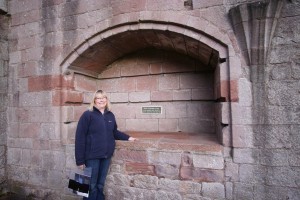 this 12th century bookshelf! The abbey was founded in 1150 by Premonstratensian monks from Northumberland who chose a spot by the River Tweed. It never quite matched the wealth and influence of other local abbeys but sadly this did not deter the marauding English armies who attacked it time and again. Like Jedburgh it fell during the 1540s and after that it became a private house and then a romantic ruin. It was bought in 1786 by David Stewart Erskine, 11th Earl of Buchan, an antiquarian. He created a magnificent garden at Dryburgh with specimen trees and classical follies. He also preserved the abbey ruins but also "improved" them with engravings and obelisks with the result that the abbey is now a mixture of the genuine medieval and the "new." Erskine also excavated the ruins and on finding a stone coffin, opened it and removed the chalice inside with two of the fingerbones of the skeleton still attached!
this 12th century bookshelf! The abbey was founded in 1150 by Premonstratensian monks from Northumberland who chose a spot by the River Tweed. It never quite matched the wealth and influence of other local abbeys but sadly this did not deter the marauding English armies who attacked it time and again. Like Jedburgh it fell during the 1540s and after that it became a private house and then a romantic ruin. It was bought in 1786 by David Stewart Erskine, 11th Earl of Buchan, an antiquarian. He created a magnificent garden at Dryburgh with specimen trees and classical follies. He also preserved the abbey ruins but also "improved" them with engravings and obelisks with the result that the abbey is now a mixture of the genuine medieval and the "new." Erskine also excavated the ruins and on finding a stone coffin, opened it and removed the chalice inside with two of the fingerbones of the skeleton still attached!
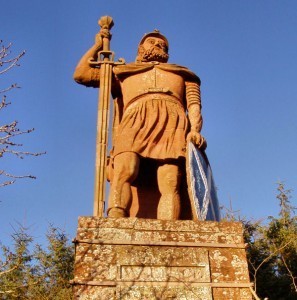 It was Erskine who had the first statue of Sir William Wallace made. We went to see it after visiting the Abbey. It is enormous! And to finish the day we
It was Erskine who had the first statue of Sir William Wallace made. We went to see it after visiting the Abbey. It is enormous! And to finish the day we watched the sunset from the top of the nearby hill, Scott's View. It is said that when Sir Walter Scott's coffin passed this way on his way to burial at Dryburgh his horse automatically stopped because it was so accustomed to him resting here. I hope Sir Walter Scott's view can inspire me in the same way that it worked its magic on him!
watched the sunset from the top of the nearby hill, Scott's View. It is said that when Sir Walter Scott's coffin passed this way on his way to burial at Dryburgh his horse automatically stopped because it was so accustomed to him resting here. I hope Sir Walter Scott's view can inspire me in the same way that it worked its magic on him!
©2011 Nicola Cornick. All Rights Reserved.
.December 7, 2011
Setting and Background in Desired
Today over at the Regency Authors' UK Blog I am talking about Greenwich London, one of the more unusual settings that I chose for part of the story in Desired. When I was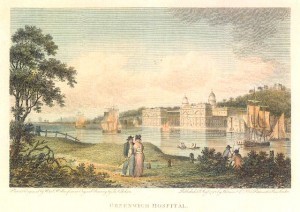 researching Greenwich I came across all sorts of historical factoids – the sort of things I love! Check out the blog to read why there was no one waiting to welcome Lord Nelson's body home and what went on in the Blackheath Caverns!
researching Greenwich I came across all sorts of historical factoids – the sort of things I love! Check out the blog to read why there was no one waiting to welcome Lord Nelson's body home and what went on in the Blackheath Caverns!
©2011 Nicola Cornick. All Rights Reserved.
.December 2, 2011
Prizewinners!
I am very happy to announce that Mary C has won my recent website contest and that Beth R has won the Scottish goodies in the blog contest. Thank you so much to everyone who entered both. I loved discussing with you the objects of your desire! There will be another blog contest coming soon; meanwhile check out my website contest for the chance to win some backlist books and an Amazon voucher. Please do visit the blog again soon – I love chatting with everyone! Have a great weekend!
entered both. I loved discussing with you the objects of your desire! There will be another blog contest coming soon; meanwhile check out my website contest for the chance to win some backlist books and an Amazon voucher. Please do visit the blog again soon – I love chatting with everyone! Have a great weekend!
©2011 Nicola Cornick. All Rights Reserved.
.December 1, 2011
Scottish Gothic!
On the Isle of Skye we came across Armadale Castle which was one of the most spooky, Gothic ruins that I have seen in a long time! It certainly added to the atmosphere that it was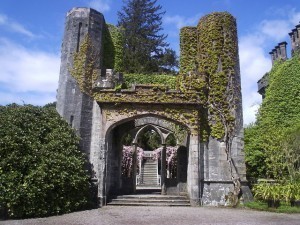 raining – absolutely pouring, in fact. The Castle is set in the most beautiful gardens and is also the home to the Museum of the Isles, which tells the fascinating story of the Clan Donald from its origins as a medieval lordship to the present day as a worldwide clan. The museum covers many topics from the Jacobites to the Highland clearances. It is one of the most vibrant and interesting museums I have ever visited. You can find out more about it here. There was also a sad, wet peacock there trying to find shelter from the rain!
raining – absolutely pouring, in fact. The Castle is set in the most beautiful gardens and is also the home to the Museum of the Isles, which tells the fascinating story of the Clan Donald from its origins as a medieval lordship to the present day as a worldwide clan. The museum covers many topics from the Jacobites to the Highland clearances. It is one of the most vibrant and interesting museums I have ever visited. You can find out more about it here. There was also a sad, wet peacock there trying to find shelter from the rain!
 Armadale was one of the homes of the MacDonald Chiefs from the 1650s and in 1690 it was burned in an attempt by the government to make Sir Donald Macdonald of Sleat submit to the new government. The Navy report of the affair states that although HMS Dartmouth bombarded the castle for several hours the walls withstood the onslaught and it was after that that the house was burned. Cannon balls from the Dartmouth have been found at Armadale. In the 18th century the mansion on the site there was used as the Dower House. Armadale was also the site of the marriage in 1750 Flora MacDonald, who helped Bonnie Prince Charlie flee Scotland after the Battle of Culloden. Samuel Johnson and James Boswell also visited the castle as part of their tour of the Isles in 1773.
Armadale was one of the homes of the MacDonald Chiefs from the 1650s and in 1690 it was burned in an attempt by the government to make Sir Donald Macdonald of Sleat submit to the new government. The Navy report of the affair states that although HMS Dartmouth bombarded the castle for several hours the walls withstood the onslaught and it was after that that the house was burned. Cannon balls from the Dartmouth have been found at Armadale. In the 18th century the mansion on the site there was used as the Dower House. Armadale was also the site of the marriage in 1750 Flora MacDonald, who helped Bonnie Prince Charlie flee Scotland after the Battle of Culloden. Samuel Johnson and James Boswell also visited the castle as part of their tour of the Isles in 1773.
The House was developed in the 1790s and the original gardens laid out in a grand style that demonstrated the wealthy lifestyle of the landed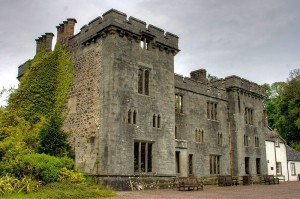 aristocracy. It was extended again in 1815 but much of the original house was destroyed in a fire in 1855 and by the 20th century the castle was a ruin open to the wind and rain as it is now. The Museum of the Isles makes Armadale well worth a visit even if you are not a fan of spooky ruined castles. The fact that I am made the trip even more fun for me!
aristocracy. It was extended again in 1815 but much of the original house was destroyed in a fire in 1855 and by the 20th century the castle was a ruin open to the wind and rain as it is now. The Museum of the Isles makes Armadale well worth a visit even if you are not a fan of spooky ruined castles. The fact that I am made the trip even more fun for me!
©2011 Nicola Cornick. All Rights Reserved.
.November 29, 2011
Desired!
Today is the official publication date for DESIRED and I am celebrating with a big giveaway here on the blog! The prize has a Scottish theme – there are cards, a calendar, a beautiful Celtic pin badge and other little gifts that I picked up on my travels. I'm also throwing in a copy of Kidnapped, the only book (so far!) of mine that is set in Scotland.
Celtic pin badge and other little gifts that I picked up on my travels. I'm also throwing in a copy of Kidnapped, the only book (so far!) of mine that is set in Scotland.
To enter, simply answer the following question:
What (or who!) is your object of desire?
I'll be drawing the contest on Friday. Thank you for visiting the blog and please do check out the rest of the site – I have beautiful new covers up plus details on the final Scandalous Women book, Forbidden and a new website contest to win some of my backlist books.
Thank you all so much for your emails and comments, and for supporting my writing. It always has and always will mean a very great deal to me.
Happy reading!
Love from Nicola
©2011 Nicola Cornick. All Rights Reserved.
.November 28, 2011
Regency Satirical Cartoons
Tomorrow sees the official launch of Desired, book 5 in my Scandalous Women of the Ton series and today I am blogging at the Word Wenches about my heroine Tess Darent's unusual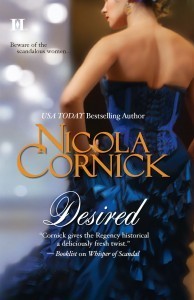 profession as an artist and caricaturist. I'm giving away a print copy of Desired as well! Drop by to share with us your own artistic or creative talents!
profession as an artist and caricaturist. I'm giving away a print copy of Desired as well! Drop by to share with us your own artistic or creative talents!
Don't forget to call back here tomorrow when I am launching my week long blog contest to celebrate the publication of Desired. There will be lots of Scottish themed goodies up for grabs!
©2011 Nicola Cornick. All Rights Reserved.
.November 23, 2011
Hook a Book!
Today I am very pleased to be invited to the Bookworm2Bookworm site to take part in "Hook a Book," their anniversary celebration. 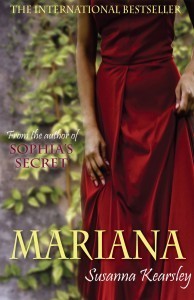 Hook a Book is a truly wonderful idea where guests are invited to tempt other readers with recommendations of their favourite books. Today I am talking about Mariana by Susanna Kearsley and giving away a copy of the book to one commenter. If you would like to be tempted and to see why I love this book, drop by the site!
Hook a Book is a truly wonderful idea where guests are invited to tempt other readers with recommendations of their favourite books. Today I am talking about Mariana by Susanna Kearsley and giving away a copy of the book to one commenter. If you would like to be tempted and to see why I love this book, drop by the site!
©2011 Nicola Cornick. All Rights Reserved.
.November 22, 2011
Inverlochy Castle
At last a fine and sunny day on our Scottish trip! After leaving Ballachulish we travelled to Fort William and stopped off at Old Inverlochy Castle. New Inverlochy Castle, built in the early Victorian era, is a hotel whilst Old Inverlochy is a ruin but it was one of the most important castles in Scotland, occupies a stunningly beautiful location and is very atmospheric. The military road built by General Wade in the 18th century passes by it and this was the route we took from Fort William.
Castle. New Inverlochy Castle, built in the early Victorian era, is a hotel whilst Old Inverlochy is a ruin but it was one of the most important castles in Scotland, occupies a stunningly beautiful location and is very atmospheric. The military road built by General Wade in the 18th century passes by it and this was the route we took from Fort William.
The castle was built in the 13th century by John "the black" Comyn, Lord of Badenoch. It was originally moated and it still retains a large bank around it with the River Lochy on one side. It was said to be on the site of an earlier Viking settlement and remained in the hands of the Comyns until Robert the Bruce took the throne in 1306. The Comyns, his enemies, were dispossessed and the castle fell into decay. In 1431 clansmen of the MacDonald Lords of the Isles defeated the forces of King James I of Scotland there at the first Battle of Inverlochy. Eventually in 1505 the partial ruin was granted to the Earl of Huntly and was fortified as a Royal garrison.
During the Civil Wars of the 1640s the royalist Earl of Montrose defeated the roundhead forces of the Campbell Chief Duke of Argyll at the second Battle of Inverlochy. In 1654 the Castle was abandoned in favour of a large timber fort built nearby by Oliver Cromwell which in 1690 was then replaced by a stone fort named Fort William after King William III. The town which grew around it was named Maryburgh after the Queen, Mary II, though eventually it took the same name as the fort.
Inverlochy is special because the ruins remain unaltered and so give an insight into the design of one of the earliest Scottish stone built castles. It is also said to be haunted – of course – and there certainly was a spooky atmosphere about the place. I'm not sure that I am brave enough to go there at night though and confront the strange creature, part-dog, part-sheep, that is said to haunt the road that leads to the castle!
©2011 Nicola Cornick. All Rights Reserved.
.


